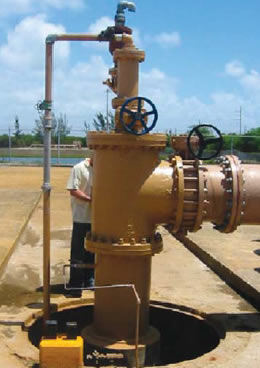Share:
OVERVIEW

An injection well is used to place fluid underground into porous geologic formations. These underground formations may range from deep sandstone or limestone, to a shallow soil layer. Injected fluids may include water, wastewater, brine (salt water), or water mixed with chemicals.
The Underground Injection Control program consists of six classes of injection wells. Each well class is based on the type and depth of the injection activity, and the potential for that injection activity to result in endangerment of a underground sources of drinking water (USDW).
- Class I wells are used to inject hazardous and non-hazardous wastes into deep, isolated rock formations.
- Class II wells are used exclusively to inject fluids associated with oil and natural gas production.
- Class III wells are used to inject fluids to dissolve and extract minerals.
- Class IV wells are shallow wells used to inject hazardous or radioactive wastes into or above a geologic formation that contains a USDW.
- Class V wells are used to inject non-hazardous fluids underground. Most Class V wells are used to dispose of wastes into or above underground sources of drinking water.
- Class VI wells are wells used for injection of carbon dioxide (CO2) into underground subsurface rock formations for long-term storage, or geologic sequestration.
The success of the deep well Underground Injection Control (UIC) program in isolating massive volumes of pollutants from underground sources of drinking water and other parts of the ecosystem has led some national policy makers to assume that no additional funding is needed, even though new challenges and responsibilities continue to be added to the program.
WHY THE UIC PROGRAM MATTERS TO GROUNDWATER
Underground injection refers to the placement of fluids into the subsurface through a well bore. The federal UIC Program, designed to prevent contamination of underground sources of drinking water (USDWs), covers wells used to inject a wide range of fluids, including oilfield brines; industrial, manufacturing, pharmaceutical, and municipal wastes; and water for solution mining. A “mature” regulatory” program suggests that the major processes are working smoothly, the principal issues are well understood, and significant problems encountered have been solved. While this is the case for Class I, II, III, and IV UIC well types, the Class V part of the UIC program has not kept pace with the rest of the program.
From the Ground Water Report to the Nation
Underground Injection Control – Summary Sheet : Full Chapter
Other Resources
News
- GWPC Provides Comments to EPA on Louisiana Class VI UIC Program Revision Application
- EPA Grants Louisiana Office of Conservation State Authority Over CO2 Injection and Sequestration
- GWPC Releases 2023 Produced Water Report
- Job Opportunities
- US Produced Water Volumes & Management Practices in 2021
- GWPC Recognizes Texas RRC for Excellence in UIC
- Updated State Guide Addresses Seismicity Induced by Fluid Injection
- California’s RBDMS 3.0: WellSTAR Release 4 Goes Live
Publications
- Modern Oil & Gas Development: 2023 Update
- Produced Water Report: Regulations & Practices Updates (2023)
- 2023 State Oil & Natural Gas Regulations Designed to Protect Water Resources (Fourth Edition)
- Class VI Regulator Training Curriculum – As Presented at GWPC Annual Forum 2022
- Potential Induced Seismicity Guide: A Resource of Technical and Regulatory Considerations Associated with Fluid Injection
- State of Kansas Class II UIC Program Peer Review
- State of California Class II UIC Program Peer Review
- New Mexico Class II UIC Program Peer Review
- State Of West Virginia Class II UIC Peer Review
- Underground Gas Storage Regulatory Considerations
- Ground Water Report to the Nation
- Ohio Class II Peer Review
- Well Integrity Regulatory Elements
- State Of Nebraska Class II UIC Program Peer Review
- State Of Utah Class II UIC Program Peer Review
- State Oil And Gas Regulations Designed To Protect Water Resources
- An Assessment Of State Needs For Regulating Geologic Sequestration Of Carbon Dioxide
Comments
- State of Louisiana Underground Injection Control Program, Class VI Program Revision Application
- Comments on EPA Applying the Supreme Court’s County of Maui v. Hawaii Wildlife Fund Decision in the Clean Water Act Section 402 National Pollutant Discharge Elimination System Permit Program
- Comments on 40 CFR Part 122 [EPA–HQ–OW–2018–0063; FRL–9973–41–OW] Clean Water Act Coverage of ‘‘Discharges of Pollutants’’ via a Direct Hydrologic Connection to Surface Water
- Comments on EPA’s Draft National Water Program Guidance 2018-2019, Publication Number 800D17001
- Comments on Proposed USDA Forest Service Directive on Groundwater Resource Management